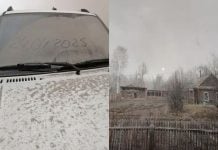The wildfires that raged in northwest America last August were so ferocious that they had the same effect on the planet as a volcanic eruption. The heat and smoke from the fires led to the formation of massive thunderstorms known as pyrocumulonimbus – pyroCbs. These storms pumped the smoke from the fires so high in the atmosphere that it spread over the entire northern hemisphere and remained there for months, until November and December.

Mike Eliason/Santa Barbara County Fire Department/Handout via REUTERS
It was by far the largest event like this ever recorded. “This was the mother of all pyroCbs,” said David Peterson of the US Naval Research Laboratory in Monterey, California, who presented his team’s finding this week at a meeting of the European Geosciences Union in Vienna.
With 2017 being a record year for wildfires in the US, the worry is that this phenomenon will become more common. PyroCbs form from wildfires when conditions are right for the hot air and smoke to generate clouds, which can sometimes develop into a full-blown thunderstorm.
“The difference is that the thunderstorm is driven by fire heat, and you end up with a very dirty thunderstorm,” said Peterson.
Last year’s fires were stratospheric
Worse still, the smoke can sometimes reach the lower stratosphere where it can spread long distances, as last year. “It’s like a great chimney taking smoke to high altitudes,” said Peterson.
On the night of 12 August, five huge pyroCbs formed simultaneously in British Columbia in Canada, and Washington state in the US. For several days they collectively formed an enormous smoke plume moving from the Canadian Arctic, over the Hudson Bay into the Atlantic Ocean. Eventually, the fallout spread across the entire northern hemisphere, remaining there until December.
“Normally, you would say ‘volcano’ with this sort of fallout,” said Peterson. “But it all came from wildfire-generated thunderstorms.”
From satellite data, Peterson estimates that the mass of the smoke was between 100,000 and 500,000 tonnes, approaching the million tonne output of Kasatochi, an Alaskan volcano that erupted in 2008. That is at least 10 times larger than the previous record-holder for the largest-observed pyroCb event, which occurred in Chisholm, Alberta, in 2011.

It also dwarves the collective effect of all wildfires across western North America in 2013, even though that year saw 26 pyroCbs develop. “It produced more stratospheric fallout in one night than the entire 2013 fire season,” said Peterson.
Whether more will develop in the future because of climate change, Peterson cannot say, because his team only has data from 2013 onwards. “But there’s potential for climate implications here,” he said.
“It’s not as simple as saying that if the temperature goes up, you’ll get more of this,” commented Etienne Tourigny of the Barcelona Supercomputing Center in Spain, who presented evidence in Vienna showing that wildfires in California’s Napa Valley last year were the most destructive in US history, killing 43 and causing damage worth $18 billion.
“But my personal opinion is that these sorts of events will likely become more frequent,” he said. “If lower latitudes become more tropical, you can probably expect more of these.”
Volcanic and climate link
In a separate talk on the potential effects of climate change on natural hazards, Gioachino Roberti of Clermont Auvergne University in France described how in 2010 a a retreating glacier lead to a huge landslide on Mount Meager, a volcano in British Columbia, which last blew 2000 years ago.
In 2016, spouts of hot, sulphurous gases called fumeroles formed in ice caves in one of its glaciers, suggesting that the landslide-which took with it part of the south flank of the volcano-had destabilised the volcano’s underlying magmatic plumbing system. “A volcano is a pressurised system, so removing a layer can lead to an eruption,” he said. The same could happen wherever glaciers on active volcanos begin to retreat…












[…] Source: Wildfire-generated thunderstorms: Fires in the US Northwest in 2017 were the biggest ever recorded a… […]
[…] article source […]
[…] Do you think this year’s fires will beat the record of 2017? […]